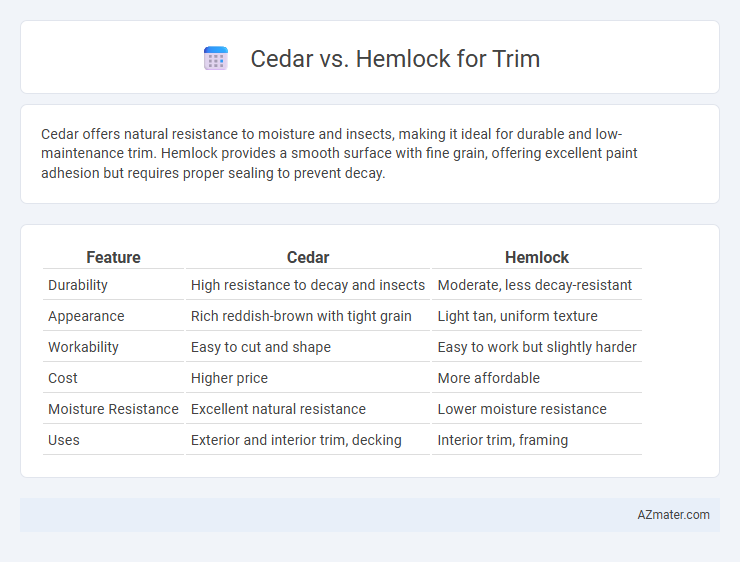Cedar offers natural resistance to moisture and insects, making it ideal for durable and low-maintenance trim. Hemlock provides a smooth surface with fine grain, offering excellent paint adhesion but requires proper sealing to prevent decay.
Table of Comparison
| Feature | Cedar | Hemlock |
|---|---|---|
| Durability | High resistance to decay and insects | Moderate, less decay-resistant |
| Appearance | Rich reddish-brown with tight grain | Light tan, uniform texture |
| Workability | Easy to cut and shape | Easy to work but slightly harder |
| Cost | Higher price | More affordable |
| Moisture Resistance | Excellent natural resistance | Lower moisture resistance |
| Uses | Exterior and interior trim, decking | Interior trim, framing |
Introduction to Wood Trim Choices
Cedar and hemlock are popular wood trim choices known for their durability and aesthetic appeal. Cedar offers natural resistance to decay and insect damage, making it ideal for exterior trim with a warm, reddish hue. Hemlock provides a smooth, uniform grain and is typically more affordable, making it suitable for painted interior trim applications.
Cedar vs Hemlock: An Overview
Cedar and hemlock offer distinct advantages for trim work, with cedar prized for its natural resistance to decay and insect damage, making it ideal for exterior applications. Hemlock, favored for its smooth grain and affordability, is commonly used in interior trim where moisture exposure is minimal. Both woods provide a stable, workable surface, but cedar's aromatic oils and longevity often justify its higher cost in projects demanding durability and aesthetic appeal.
Appearance and Grain Comparison
Cedar trim features a rich reddish-brown hue with a straight, fine grain that provides a smooth, uniform appearance, ideal for enhancing architectural detail. Hemlock trim offers a lighter, pale yellow to light brown color with a more subtle, less pronounced grain pattern, giving a clean and understated look. Cedar's natural oils contribute to its smooth texture and vibrant color, while Hemlock's grain tends to be tighter and less varied, making it suitable for painted finishes.
Durability and Longevity
Cedar trim offers exceptional durability due to its natural resistance to rot, decay, and insect damage, making it ideal for exterior applications. Hemlock, while less resistant to moisture and insects, provides good strength but typically requires protective finishes to ensure longevity. Cedar's inherent oils contribute to a longer lifespan in harsh weather conditions, often outlasting hemlock by several years in similar environments.
Resistance to Rot and Insects
Cedar trim offers superior resistance to rot and insects due to its natural oils and tight grain structure, making it ideal for outdoor applications and high-moisture environments. Hemlock, while more affordable, lacks the same level of natural protection and is more prone to insect damage and decay without proper treatment. Choosing cedar ensures longer-lasting trim with minimal maintenance in settings exposed to weather and pests.
Workability and Ease of Installation
Cedar trim is prized for its excellent workability, as its lightweight and soft texture allow for easy cutting, sanding, and nailing, making installation faster and less labor-intensive. Hemlock, while slightly harder and denser, remains relatively easy to work with but may require sharper tools and more effort for smooth finishes. Both woods provide good nail-holding strength, but cedar's natural resistance to splitting and warping enhances ease of long-term installation and maintenance.
Environmental Impact and Sustainability
Cedar trim offers superior environmental benefits due to its natural resistance to decay, reducing the need for chemical treatments and frequent replacement, which minimizes resource consumption. Hemlock, while abundantly available, often requires preservative treatments that can introduce toxic substances into the environment, posing sustainability challenges. Choosing cedar supports sustainable forestry practices when sourced from certified forests, contributing to lower carbon footprints compared to hemlock processed with chemical preservatives.
Cost Analysis: Cedar vs Hemlock
Cedar trim typically costs between $3 and $8 per linear foot, making it a mid-range option known for natural resistance to decay and insect damage. Hemlock trim, usually priced around $2 to $4 per linear foot, offers a more budget-friendly choice but requires additional treatment for weather resistance and durability. Evaluating long-term maintenance costs is crucial, as cedar's inherent properties reduce upkeep expenses compared to the more porous, less durable hemlock.
Best Uses for Cedar and Hemlock Trim
Cedar trim is prized for its natural resistance to rot, decay, and insect damage, making it ideal for outdoor applications such as fascia, soffits, and window casings exposed to moisture. Hemlock trim offers a smooth, uniform grain and excellent paint adhesion, making it a popular choice for interior trim work like baseboards, door casings, and crown moldings where a clean, paint-ready surface is essential. Both woods provide durable options, but cedar excels in exterior durability while hemlock is preferred for interior finishes requiring high-quality paint surfaces.
Final Recommendation: Which Wood is Better for Trim?
Cedar offers superior natural resistance to rot and insects, making it an excellent choice for trim in areas prone to moisture. Hemlock provides a smoother finish and is generally more cost-effective, ideal for interior trim where budget and paint adhesion are priorities. For exterior trim requiring durability and longevity, cedar is the better option, while hemlock suits interior projects needing a clean, paint-ready surface.

Infographic: Cedar vs Hemlock for Trim
 azmater.com
azmater.com